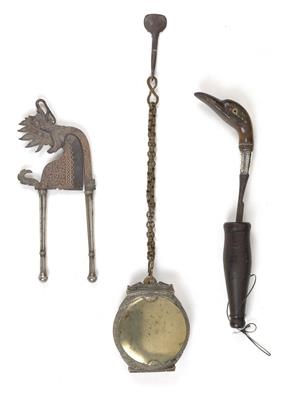Mixed lot (3 items): Indonesia: Three implements for betel nut chewing.

In south-east Asia, the chewing of betel nut for pleasure is widespread. To do so, the following utensils are used: Pliers (or scissors) with a sharp edge, to cut up the areca nuts. A mortar and pestle to crush these ‘betel nuts’. And furthermore, a container for slaked, white, pulverised lime. Then you add various flavourings, wrap the whole thing in the leaf of a pepper plant and chew the small ‘package’ in your mouth for a prolonged period. Weak alkaloids within the ‘betel awl’ create a slightly stimulating effect. Long years of chewing betel will dye the teeth red.
Over time, the implements needed for chewing betel nut (pliers, mortar and pestle, lime containers), were manufactured and decorated in characteristic, local forms, typical styles, and often made out of precious materials. Such as the betel-implements on offer here:
1: Island of Bali: A typical set of betel pliers, iron forged. In the form of a winged, mythical animal, with the head of the sea monster ‘Makara’. With rich, damascene decorations in copper or reddish ‘sterling silver’ (a silver-copper alloy): in straight and zig-zag lines (also with star- and swastika motifs), as well as in surfaces. Both plier-grips are coated with silver. H: 10 cm, L: 13 cm.
2: Island of Lombok: A betel mortar in the typical Lombok form. The mortar is made out of dark, hard wood. The pestle is iron forged and has a horn grip in the form of a duck’s head, very finely and expertly carved in relief, with inlaid eyes made of ivory-rings, and a high, silver coated gripping-ring underneath. H: 30 cm.
3: Sumatra: A round, flat lime tin, brass cast. Hinged at the bottom, catch fastener on top, shiny, round surfaces on the sides, and rich, floral decorations along the borders (‘waste mould casting’). Includes a chain of cast brass links attached to the top and an iron ‘spoon’ for removing lime from the tin. DM: c. 11-12 cm. About 4 cm thick.
All three betel implements: Between the 19th century and the beginning of the 20th century. (ME) ASA
Provenance: German Private Collection.
Expert: Prof. Erwin Melchardt
 Prof. Erwin Melchardt
Prof. Erwin Melchardt
+43-1-515 60-465
erwin.melchardt@dorotheum.at
26.05.2015 - 15:00
- Dosažená cena: **
-
EUR 500,-
- Odhadní cena:
-
EUR 800,- do EUR 900,-
Mixed lot (3 items): Indonesia: Three implements for betel nut chewing.
In south-east Asia, the chewing of betel nut for pleasure is widespread. To do so, the following utensils are used: Pliers (or scissors) with a sharp edge, to cut up the areca nuts. A mortar and pestle to crush these ‘betel nuts’. And furthermore, a container for slaked, white, pulverised lime. Then you add various flavourings, wrap the whole thing in the leaf of a pepper plant and chew the small ‘package’ in your mouth for a prolonged period. Weak alkaloids within the ‘betel awl’ create a slightly stimulating effect. Long years of chewing betel will dye the teeth red.
Over time, the implements needed for chewing betel nut (pliers, mortar and pestle, lime containers), were manufactured and decorated in characteristic, local forms, typical styles, and often made out of precious materials. Such as the betel-implements on offer here:
1: Island of Bali: A typical set of betel pliers, iron forged. In the form of a winged, mythical animal, with the head of the sea monster ‘Makara’. With rich, damascene decorations in copper or reddish ‘sterling silver’ (a silver-copper alloy): in straight and zig-zag lines (also with star- and swastika motifs), as well as in surfaces. Both plier-grips are coated with silver. H: 10 cm, L: 13 cm.
2: Island of Lombok: A betel mortar in the typical Lombok form. The mortar is made out of dark, hard wood. The pestle is iron forged and has a horn grip in the form of a duck’s head, very finely and expertly carved in relief, with inlaid eyes made of ivory-rings, and a high, silver coated gripping-ring underneath. H: 30 cm.
3: Sumatra: A round, flat lime tin, brass cast. Hinged at the bottom, catch fastener on top, shiny, round surfaces on the sides, and rich, floral decorations along the borders (‘waste mould casting’). Includes a chain of cast brass links attached to the top and an iron ‘spoon’ for removing lime from the tin. DM: c. 11-12 cm. About 4 cm thick.
All three betel implements: Between the 19th century and the beginning of the 20th century. (ME) ASA
Provenance: German Private Collection.
Expert: Prof. Erwin Melchardt
 Prof. Erwin Melchardt
Prof. Erwin Melchardt
+43-1-515 60-465
erwin.melchardt@dorotheum.at
|
Horká linka kupujících
Po-Pá: 10.00 - 17.00
kundendienst@dorotheum.at +43 1 515 60 200 |
| Aukce: | Mimoevropské a domorodé umění |
| Typ aukce: | Salónní aukce |
| Datum: | 26.05.2015 - 15:00 |
| Místo konání aukce: | Wien | Palais Dorotheum |
| Prohlídka: | 20.05. - 26.05.2015 |
** Kupní cena vč. poplatku kupujícího a DPH
Není již možné podávat příkazy ke koupi přes internet. Aukce se právě připravuje resp. byla již uskutečněna.
